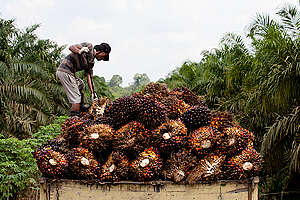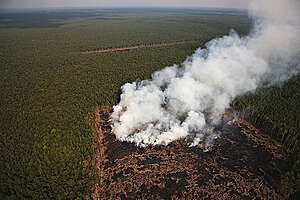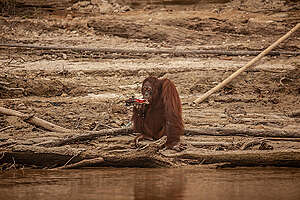Palm Oil
Every hour up to 300 football fields of Indonesian rainforest are destroyed to make room for palm oil plantations. Greenpeace is fighting to stop the sourcing of unethical “dirty palm oil” to protect the homes of indigenous peoples and endangered species.


Add your name and tell big brands to stop using palm oil from forest destroyers.
The problem
The impacts of climate change on humans, our societies, wildlife and our environment are wide – and differ greatly across the globe. Health implications, infrastructure, food and water – almost everything humans need for survival is at risk if average global temperatures continue to rise.
What is Greenpeace doing?
Greenpeace and other organisations are fighting to ensure that palm oil is produced in a sustainable way, without forest destruction. Palm oil was once produced by local communities responsibly without massive scale forest destruction and burning. Industrial players must follow responsible agricultural practices that would protect the forests, contribute to the local economic development and respect the social and economic rights of local inhabitants.
That is why Greenpeace has been working on many fronts and have successfully persuaded global companies such as Mars, Unilever or Nestlé to sign commitments to stop using unsustainable palm oil. We keep increasing the pressure to make sure corporations around the world only purchase palm oil from sustainable suppliers, those that don’t destroy rainforests.

What is palm oil?

Palm oil is a type of vegetable oil that comes from the fruits in a few species of palm trees. In fact, this fruit produces two kinds of oil: oil from the pulp, typically used in food like chocolate or breakfast cereals, and oil from the seed which is often used in soap and shampoo.
Even though the two main species of palm oil trees come from Africa (Elaeis guineensis) and South America (Elaeis oleifera), they are mostly farmed in New Guinea, Indonesia and Malaysia.
What is palm oil used for?

Palm oil is everywhere. From soap to cosmetics to your favourite foods, palm oil is even used as biofuel for vehicles. Amazingly, palm oil can be found in a massive 40% to 50% of household products in Australia. It’s used so extensively because of its numerous benefits: cheap production, long shelf life and its efficiency in terms of land use. All in all, companies can use palm oil to produce competitively priced products. This has caused an enormous spike in demand for palm oil. Indonesia is leading in producing palm oil with approximately 15 million hectares of land licensed for palm oil development.
What are the problems with Palm Oil?
Palm oil plantation environmental threats

Fire, deforestation and smog
Fire is often used as part of the deforestation process which can spread and affect local communities directly. In cases where the fire is kept under control, the smoke produced can cause drastic health concerns, including diseases associated with smoke inhalation, resulting in thousands of premature deaths.
Orangutans

The Bornean Orangutan is now classified as “critically endangered”. The leading cause? Habitat loss due to forest clearing for plantations.
The Orangutan is an intelligent and beautiful species of Great Apes which spends the most time in trees of all Great Apes. Aside from the potential tragedy of losing such precious creatures for their own sake, they are also keystone species in these ecosystems, maintaining a careful balance by distributing seeds from fruit that they consume as part of their varied diet. In a practical sense, losing Orangutans could have dire impacts on the health of the ecosystem.
Climate change
Dirty palm oil industries are fuelling climate change. The fires used to burn rainforests in preparation for new plantations produce large quantities of greenhouse gasses contributing towards warming the planet but also removing the rainforests necessary for absorbing the greenhouse gasses out of the atmosphere.
Poaching
Finally the roads created for palm oil plantation owners and loggers provide easy access to poachers and ‘exotic’ endangered animal smugglers. Without these roads, poachers were cut off from the depths of the forests effectively giving endangered animals a sanctuary to live, breed and recover. Now, they have direct and easy access causing further threats to Orangutans and other critically endangered species.
Dirty palm oil – who is responsible?

Even though the dirty palm oil industry is responsible for destroying precious forested areas in Indonesia and across South East Asia, big corporations that deliberately source from these suppliers are as guilty for the tropical forest destruction as the suppliers themselves. According to a report from Greenpeace, the palm oil demand from the largest brands, including Unilever, Nestlé, Colgate-Palmolive and Mondelez have led to the destruction of forested areas twice as big as Singapore in less than three years!
The report (assessing deforestation from 25 palm oil suppliers) also found that:
- These groups have cleared over 130,000ha of rainforest since the end of 2015
- 40% of deforestation (51,600ha) took place in Papua, Indonesia – one of the most biodiverse region on our planet
- 12 global companies sourced from at least 20 of the dirty palm oil suppliers. The 12 companies are Colgate-Palmolive, L’Oreal, Hershey, Kellogg’s, Kraft, Mars, Mondelez, General Mills, Heinz, Nestlé, PepsiCo, Reckitt Benckiser and Unilever.
Wilmar, the world’s largest palm oil trader, plays a role in the forest undergrowth as it buys from 18 of these 20 palm oil suppliers. In 2013, Greenpeace International revealed that Wilmar and its suppliers were linked not only to deforestation, but also illegal and extensive clearance of tiger habitat. Later that same year the company announced a new policy aiming ‘no deforestation, no peat, no exploitation’. However, Greenpeace found that the group is still sourcing dirty palm oil and causing further destruction of pristine rainforests.
Are some palm oil products ok?
You don’t need to stop using palm oil products. However, if you want to make sure you’re not indirectly supporting dirty palm oil companies you can make sure that you’re not purchasing products from irresponsible suppliers. The best option to find responsibly produced palm oil products is to check for the Responsibly sourced palm oil (RSPO) label. If you don’t have this alternative, look then for palm oil products with the Green Palm label, which supports the transition to certified palm oil. The money from Green Palm help growers transiting to sustainable palm oil. Keep in mind that such purchases for sustainable products has the power to lead to a snowball effect that would help end those destructive practices.
You can help bring an end to the destruction of our forests
Your ongoing support is the most effective way to contribute by helping us with long term campaign strategies.
Keep informed
Together we are part of a growing, global movement determined to bring about the changes our planet desperately needs. Sign up to receive updates on our campaigns.